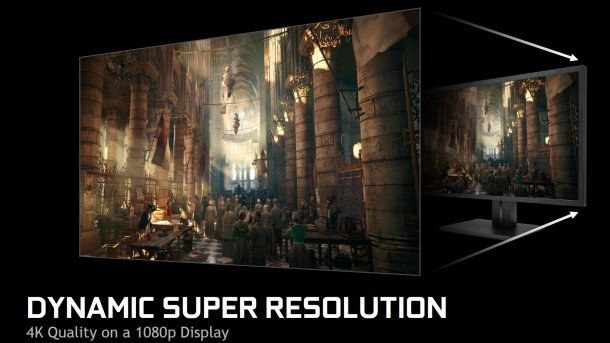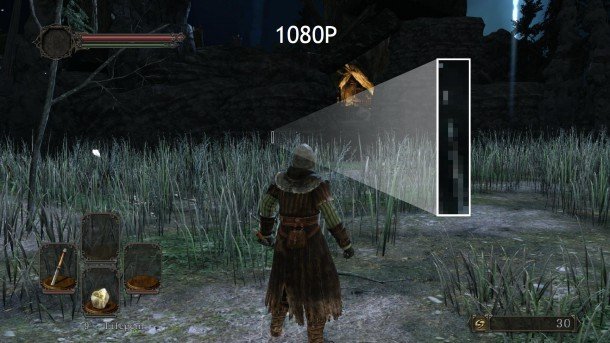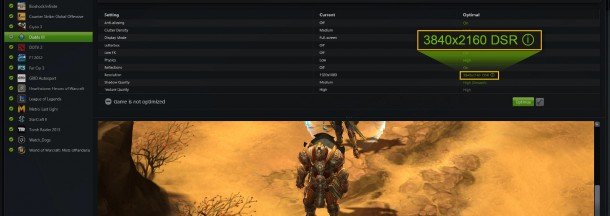Nvidia's Dynamic Super Resolution is downsampling made easy

Back in April, Dark Souls modder Durante revealed a new tool he'd written called GeDoSaTo , or Generic Downsampling Tool. Downsampling is like the ultimate brute force anti-aliasing solution--it involves running a game at a high resolution, like 1440p or 4K or even 8K--and then using an algorithm to rescale that image to your monitor's native, like 1080p. Downsampled games look amazingly sharp, but downsampling usually requires some tricky hacks, like adjusting monitor timings or modifying game files. GeDoSaTo made it possible to downsample games more easily than ever before, but it's still a mod tool, and all mod tools require trial and error and tinkering.
Well, Nvidia's been paying attention. One of the major features coming to Maxwell GPUs like the GTX 980 is called Dynamic Super Resolution—and it's just downsampling, but with official driver support instead of hacking. The favorite technique of hardcore PC screenshotters is coming to the masses.
A future GeForce Experience driver for Maxwell GPUs (it wasn't yet enabled when I tested the GTX 980 pre-launch) will include a customizable Dynamic Super Resolution option alongside other GFE basics like anti-aliasing and anisotropic filtering. On a powerful enough card, GFE may even click on Dynamic Super Resolution when you press the optimize button.
At release, DSR will be exclusive to Maxwell, but Nvidia's director of technical marketing Tom Petersen said at Nvidia Editor's Day that a rollout to older cards was "very likely." Petersen showed off DSR on stage at Editor's Day using Dark Souls 2 as an example. He demoed the visible scintillation effect that happens when panning the camera around a field of grass. At 1080p, the sample resolution of the screen is too low to capture entire blades of grass, so some parts of the texture slip through the pixel grid and aren't sampled. That leads to a shimmery effect. When the game is running at 4K with DSR, though, the higher resolution sample grid leads to more grass pixels being sampled, which creates a more solid image.

Above and below: Nvidia's demonstration of how sampling more pixels improves image quality.

If you're familiar with downsampling, you knew all of that already. Downsampling is a great way to cut down on aliasing and bring out the texture detail in games you wouldn't see at a lower resolution. Nvidia's implementation is exciting for two reasons. One, it's easy to turn on, which means gamers who have never fiddled with downsampling will now be able to. Two, Nvidia is claiming that its downsampling implementation will be better quality--and more widely compatible--than the downsampling hacks gamers have been using.
“We're not using the hardware pipeline to do the scaling," Petersen said in his presentation. "We have a separate stage to do the filtering to bring a 4K image down to 19x10. It's also transparent to the game. It's not sneaking past the game to do supersampling. In the postprocessing framebuffer we scale it down to 19x10."
Keep up to date with the most important stories and the best deals, as picked by the PC Gamer team.
After the presentation, I checked out a demo of DSR and talked to technical marketing manager Andrew Coonrad to get more details. DSR can be enabled with a single click in GeForce Experience, but it's thankfully a bit more customizable than that. Tinkerers can go into the Nvidia control panel to customize a game's render resolution in steps up to 4K. DSR currently doesn't support high resolutions, like 6K or 8K, which Durante's GeDoSaTo can do. GeDoSaTo is the more customizable tool, but it works with a (relatively) narrow selection of games. It's currently limited to DirectX9.
"This is the big boy corporate version of [GeDoSaTo]," said Coonrad. We have a lot of engineers and a lot of time, and we have access to our drivers. It's compatible with...I'm not going to say all games because I haven't tested all games, but most games. There are some games where even rendering past 1080 is challenging, because the engine itself can't do it, or the INF list of resolutions that are available doesn't work. There are some other complications that can happen with multiple resolutions, but what this does is it tells the driver: 'Hey I have all these other resolutions I can render at, tell the game I have more resolutions.' ... So if the game is compatible with 4K, it will be compatible with this technology."

DSR can't fix the issues that certain games, particularly older games, have with downsampling—like a non-scaling UI that becomes teensy-tiny at high res. But Nvidia has the benefit of crowdsourcing on their side. While the mod community is constantly collaborating to improve their own homebrew tools, Nvidia can collect data from thousands or even millions of GeForce Experience users.
"We've done a lot of testing, but we can't test every single game out there, right?" said Coonrad. "I'm sure there will be titles where it's like, holy fuck this is amazing, it fixed everything, I can now play Homeworld 1 at 8K or whatever. Fantastic! Great. But if there are issues, that's what so cool about GFE, we have a feedback button, so people can say hey, I tried this, it didn't work, help me fix it. We take that really seriously. We'll go in and look at what happened and try to fix it and try to make it work for every game."
I'm eager to see Nvidia support resolutions higher than 4K with Dynamic Super Resolution, and eager to see them broaden support from their new Maxwell GPUs back to older cards, which can already handle downsampling via modding. The easier downsampling gets, the better. And even if Nvidia says modders weren't the direct impetus for DSR, I think Durante and Dead End Thrills can still safely claim credit for making the PC downsampling community too big too ignore.

Wes has been covering games and hardware for more than 10 years, first at tech sites like The Wirecutter and Tested before joining the PC Gamer team in 2014. Wes plays a little bit of everything, but he'll always jump at the chance to cover emulation and Japanese games.
When he's not obsessively optimizing and re-optimizing a tangle of conveyor belts in Satisfactory (it's really becoming a problem), he's probably playing a 20-year-old Final Fantasy or some opaque ASCII roguelike. With a focus on writing and editing features, he seeks out personal stories and in-depth histories from the corners of PC gaming and its niche communities. 50% pizza by volume (deep dish, to be specific).

